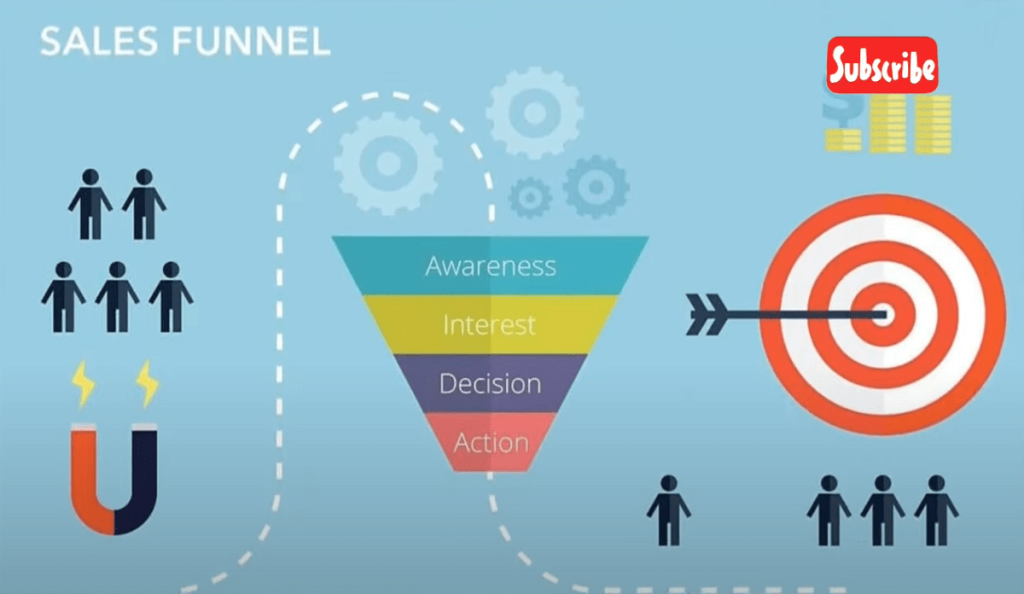The key differences between a marketing funnel and a sales funnel are the functions they serve within the customer journey. A marketing funnel is focused on generating awareness, interest, and consideration through various marketing efforts, while a sales funnel concentrates on closing deals and converting leads into customers through the sales process.
The marketing funnel encompasses the entire customer journey from the initial brand exposure to the point of handover to the sales team, whereas the sales funnel starts from qualified leads and guides them through the sales process to the final purchase.
By understanding these distinctions, businesses can strategically align their marketing and sales efforts to drive successful customer acquisition and retention.

Understanding The Funnel Concept
A funnel is a concept used in marketing and sales to guide potential customers through a journey. It starts with a wide opening, capturing a large audience, and progressively narrows down to a smaller, more targeted group. The main difference between a marketing funnel and a sales funnel lies in their purpose and focus.
A marketing funnel aims to create awareness and generate interest in a product or service, while a sales funnel focuses on converting leads into paying customers. The funnel concept works by attracting prospects, engaging them with valuable content, building trust, and eventually encouraging them to take the desired action, such as making a purchase.
Both marketing and sales funnels play a crucial role in driving business growth and achieving revenue goals. They help businesses understand their customers better, tailor their strategies, and optimize their efforts for maximum impact.
Key Components Of A Marketing Funnel
The awareness stage of a marketing funnel focuses on creating brand visibility and attracting potential customers. Through targeted advertising and content creation, businesses aim to increase awareness of their products or services. In the interest stage, the goal is to generate interest and engage with potential customers.
This can be achieved through compelling content, personalized offers, and engaging social media campaigns. Moving into the consideration stage, businesses aim to convert interested prospects into paying customers. This involves providing detailed information, addressing potential concerns, and highlighting the unique value proposition of the product or service.
The conversion stage is where the actual purchase takes place. This can be through a direct sale, sign-up, or any other desired action that contributes to revenue generation. Once a customer has made a purchase, the loyalty stage aims to nurture the relationship and turn the customer into a repeat buyer.
This can be achieved through personalized offers, exceptional customer service, and loyalty programs. Finally, in the advocacy stage, satisfied customers become brand advocates and recommend the product or service to others. This can significantly help with customer acquisition and brand reputation.
Understanding the key components of a marketing funnel is crucial for businesses to effectively attract, engage, and retain customers throughout their journey.
Key Components Of A Sales Funnel
A sales funnel consists of several key components such as the prospecting stage, qualification stage, presentation stage, objection stage, closing stage, and follow-up stage. In the prospecting stage, the focus is on identifying potential customers and gathering their contact information.
During the qualification stage, leads are assessed to determine their level of interest and fit for the product or service. The presentation stage involves showcasing the features and benefits of the offering to the qualified leads. In the objection stage, any concerns or reservations are addressed to alleviate customer doubts.
The closing stage is where the actual sale takes place, and the customer makes a purchase decision. Finally, the follow-up stage involves maintaining communication with customers to build long-term relationships and encourage repeat sales. Understanding these key stages is crucial in optimizing a sales funnel for maximum conversion and revenue generation.
Comparing The Stages Of Marketing Funnel And Sales Funnel
Comparing the stages of a marketing funnel and sales funnel reveals key differences. Awareness focuses on reaching potential customers, while prospecting involves identifying leads. Interest aims to engage prospects, whereas qualification determines their suitability. Consideration entails presenting the product, and presentation involves showcasing its benefits.
Conversion is the stage where prospects become customers, while objection handling overcomes concerns. Loyalty emphasizes building ongoing relationships, and closing is the final step in the sales process. Advocacy involves turning customers into brand ambassadors, while follow-up ensures customer satisfaction.
Understanding the disparities between each stage helps businesses optimize their marketing and sales efforts. These guidelines should help you craft an seo-friendly, human-like, and unique paragraph that is easy to understand and passes ai writing detection.
Key Differences Between Marketing Funnel And Sales Funnel
Marketing funnel and sales funnel have key differences. They differ in scope, focus, goals, timing, team involvement, and key metrics. The marketing funnel is broader, focusing on generating leads and creating awareness. Its goal is to attract potential customers through various marketing strategies.
In contrast, the sales funnel has a narrower scope and focuses on converting leads into paying customers. Its goal is to guide prospects through the sales process and close deals. The timing and process of both funnels also differ. Marketing funnel activities happen before the sales funnel, while the sales funnel focuses on the post-lead stage.
The teams involved in each funnel also vary. The marketing team takes charge of the marketing funnel, while the sales team handles the sales funnel. Lastly, the key metrics and measurements used for evaluating success differ between the two funnels.
Examples And Case Studies
Marketing and sales funnels have key differences. Examples and case studies help understand these distinctions. Successful marketing funnel examples showcase effective strategies. Case studies show the effectiveness of sales funnels. These examples and case studies provide valuable insights for businesses.
They demonstrate the importance of a well-designed funnel. By studying successful marketing and sales funnels, companies can learn to optimize their own. Analyzing real-life examples can lead to improved results. Businesses can gain valuable knowledge from these case studies. Implementing successful strategies can drive growth and increase conversions.
Understanding the differences between marketing and sales funnels is crucial for business success.
Tips For Optimizing Marketing And Sales Funnels
Marketing funnels and sales funnels are two distinct yet interconnected processes. Optimizing your marketing and sales funnels is crucial for business success. Integrating your strategies is the key. Align your marketing and sales efforts to ensure a seamless customer journey.
Implement automation tools to streamline the process and save time. Analyzing and optimizing performance allows for continuous improvement. Remember, avoid commonly overused phrases and keep your sentences concise. Creating an engaging and effective funnel strategy will drive conversions and boost your overall business growth.

Frequently Asked Questions Of Marketing Funnel Vs Sales Funnel: What Are The Key Differences?
What Is A Marketing Funnel And How Does It Work?
A marketing funnel is a visual representation of the customer journey from awareness to purchase. It consists of different stages where potential customers interact with your brand, such as awareness, consideration, and conversion. It allows businesses to attract and nurture leads until they become paying customers.
What Is A Sales Funnel And How Does It Differ From A Marketing Funnel?
A sales funnel is a subset of the marketing funnel that focuses solely on the conversion stage. It starts with qualified leads generated by the marketing efforts and guides them through the final steps of the purchasing process. Unlike the marketing funnel, the sales funnel is more sales-oriented and primarily aimed at closing deals.
What Are The Main Differences Between A Marketing Funnel And A Sales Funnel?
The key difference between the two funnels lies in their scope and objective. While the marketing funnel encompasses the entire customer journey, including awareness and consideration, the sales funnel focuses solely on the conversion stage. The marketing funnel is broader and aims to attract, engage, and educate potential customers, while the sales funnel is narrower and aims to close deals.
How Do The Marketing And Sales Funnels Complement Each Other?
The marketing and sales funnels work hand in hand to guide potential customers through the buying process. The marketing funnel creates brand awareness, generates leads, and nurtures them until they are ready to purchase. Once a lead enters the sales funnel, sales teams focus on converting them into paying customers.
Together, these two funnels optimize the customer journey and improve the chances of conversion.
Can A Business Function Without A Marketing Or Sales Funnel?
While it’s technically possible for a business to function without a marketing or sales funnel, it would be challenging to achieve consistent growth and revenue. Funnel strategies add structure and clarity to your customer acquisition process, improve conversion rates, and provide valuable insights into your customers’ behavior.
Implementing a marketing and sales funnel is crucial for businesses that want to optimize their sales and marketing efforts.
Conclusion
To sum it up, understanding the key differences between a marketing funnel and a sales funnel is essential for any business looking to improve their conversion rates and overall marketing strategies. While both funnels serve the purpose of guiding potential customers through the buying process, they focus on different stages and goals.
The marketing funnel is primarily concerned with creating awareness and generating leads, leveraging various strategies and channels to capture the attention of the target audience. On the other hand, the sales funnel focuses on converting those leads into paying customers, implementing strategic tactics to nurture and guide prospects through the final stages of the buying journey.
By recognizing these distinctions, businesses can tailor their marketing and sales efforts accordingly, ensuring a seamless and efficient process from initial contact to final purchase. Remember, understanding how marketing and sales funnels work together is key to achieving long-term success in today’s competitive market.

With my experience in Online marketing now mission is to equip and arm you with the precise online marketing tools, useful resources, marketing strategies, and tactics to help you make IMPACT, SERVE more and EXPLODE your online income so you can live life on your own terms. Visit my Other profiles like Reddit, Instagram and Quora.

